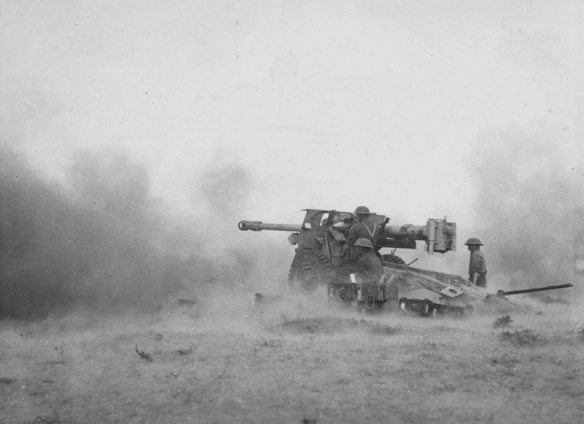17/25-pounder “Pheasant” caught in full recoil firing in Tunisia – 1943
Before the QF 6-pounder had entered service, the British predicted that it would soon be inadequate given the increasing armour of German tanks. In late 1940, design of a replacement was started, and was largely complete by the end of 1941. A prototype production line was set up that spring, and with the appearance of Tiger I tanks in early 1943 in the North Africa, the first 100 prototype 17-pounder anti-tank guns were quickly sent to help counter this new threat. So great was the rush that they were sent before proper carriages had been developed, and the guns had to be mounted in the carriages of 25-pounder gun-howitzers. These early weapons were known as 17/25-pounders and given the codename Pheasant. They first saw action in February 1943.
When the allies encountered the first Tiger tanks in Africa in 1942 nothing they fielded at that time could effectively take these big cats on. The 17 pounder gun itself was available but the production of its carriage was lagging behind. As a stop gap measure some 17 pounder barrels were fitted onto 25 pounder carriages (incidentally that was also how the 25 pounder field gun concept started out: being fielded on the 18 pounder field gun carriage……): enter the 25/17 pounder, code name ‘Pheasant’. Some 150 units were produced.
At this early stage of the war only AP (solid) shot would have been available, some APC (capped) rounds might have been issued later in 1942 but at that time most Pheasants were probably already converted to ‘full’ 17pdr’s.
Generally the riveted 25 pounder carriage could sustain the abuse of the high velocity gun quite well. The first supplies of ammunition however did seem to suffer from accuracy issues and the solid shot projectiles prone to shatter on surface hardened armor plate. The later introduced cap prevented it from shattering at oblique impact angles.
The ‘Pheasant’ is certainly not the most refined looking gun, but this ugly duckling would profile itself as a potent tank killer and was a great boost for morale.
As one looks closely to the production 17 pounders the barrel slide and cradle are virtually identical. And with some minor adjustments the new barrel and slide could be fitted into the 25 pounder cradle. Main external (visible) change to the 25 pounder carriage was the firing mechanism which, due to the breech being much further backwards, was mounted on an extension arm bolted to the gun cradle.
